alarm JEEP RENEGADE 2018 Owner handbook (in English)
[x] Cancel search | Manufacturer: JEEP, Model Year: 2018, Model line: RENEGADE, Model: JEEP RENEGADE 2018Pages: 356, PDF Size: 6.11 MB
Page 17 of 356
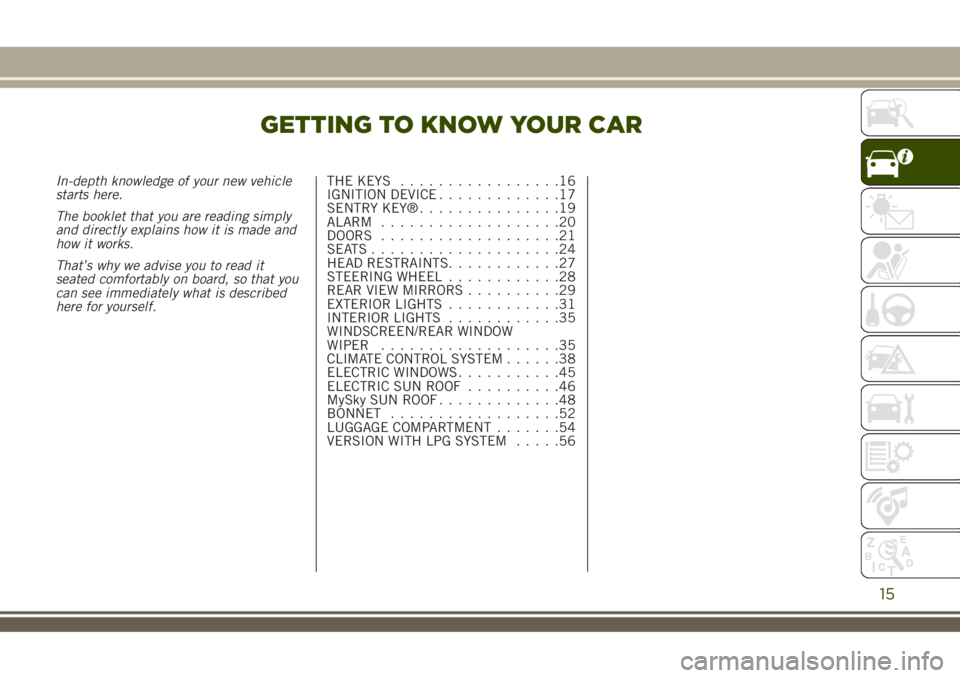
GETTING TO KNOW YOUR CAR
In-depth knowledge of your new vehicle
starts here.
The booklet that you are reading simply
and directly explains how it is made and
how it works.
That’s why we advise you to read it
seated comfortably on board, so that you
can see immediately what is described
here for yourself.THE KEYS.................16
IGNITION DEVICE.............17
SENTRY KEY®...............19
ALARM...................20
DOORS...................21
SEATS....................24
HEAD RESTRAINTS............27
STEERING WHEEL............28
REAR VIEW MIRRORS..........29
EXTERIOR LIGHTS............31
INTERIOR LIGHTS............35
WINDSCREEN/REAR WINDOW
WIPER...................35
CLIMATE CONTROL SYSTEM......38
ELECTRIC WINDOWS...........45
ELECTRIC SUN ROOF..........46
MySky SUN ROOF.............48
BONNET..................52
LUGGAGE COMPARTMENT.......54
VERSION WITH LPG SYSTEM.....56
15
Page 19 of 356
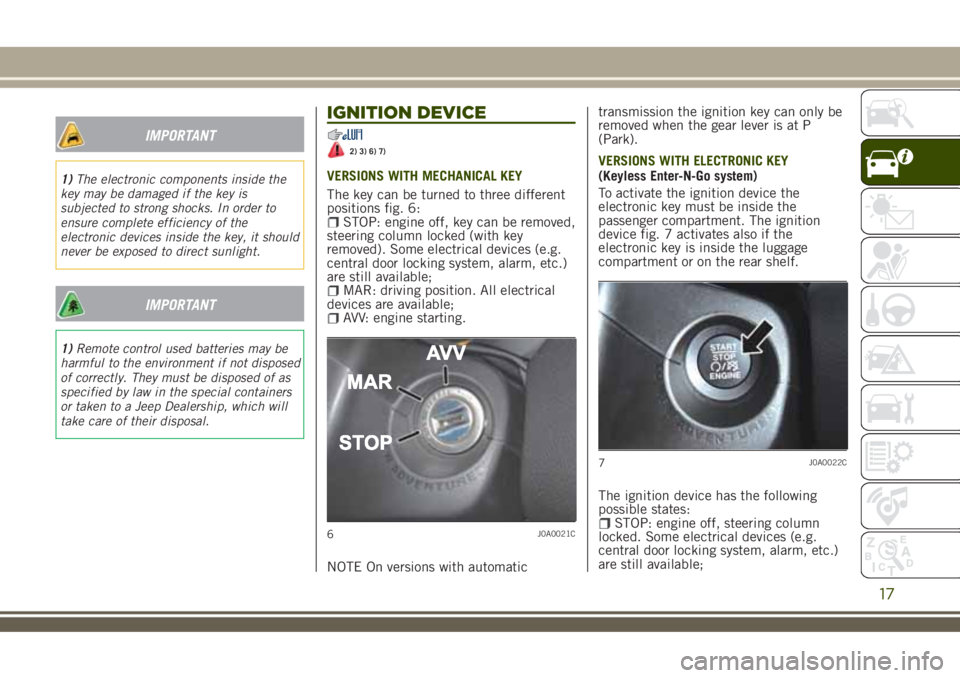
IMPORTANT
1)The electronic components inside the
key may be damaged if the key is
subjected to strong shocks. In order to
ensure complete efficiency of the
electronic devices inside the key, it should
never be exposed to direct sunlight.
IMPORTANT
1)Remote control used batteries may be
harmful to the environment if not disposed
of correctly. They must be disposed of as
specified by law in the special containers
or taken to a Jeep Dealership, which will
take care of their disposal.
IGNITION DEVICE
2) 3) 6) 7)
VERSIONS WITH MECHANICAL KEY
The key can be turned to three different
positions fig. 6:
STOP: engine off, key can be removed,
steering column locked (with key
removed). Some electrical devices (e.g.
central door locking system, alarm, etc.)
are still available;
MAR: driving position. All electrical
devices are available;
AVV: engine starting.
NOTE On versions with automatictransmission the ignition key can only be
removed when the gear lever is at P
(Park).
VERSIONS WITH ELECTRONIC KEY
(Keyless Enter-N-Go system)
To activate the ignition device the
electronic key must be inside the
passenger compartment. The ignition
device fig. 7 activates also if the
electronic key is inside the luggage
compartment or on the rear shelf.
The ignition device has the following
possible states:
STOP: engine off, steering column
locked. Some electrical devices (e.g.
central door locking system, alarm, etc.)
are still available;6J0A0021C
7J0A0022C
17
Page 22 of 356
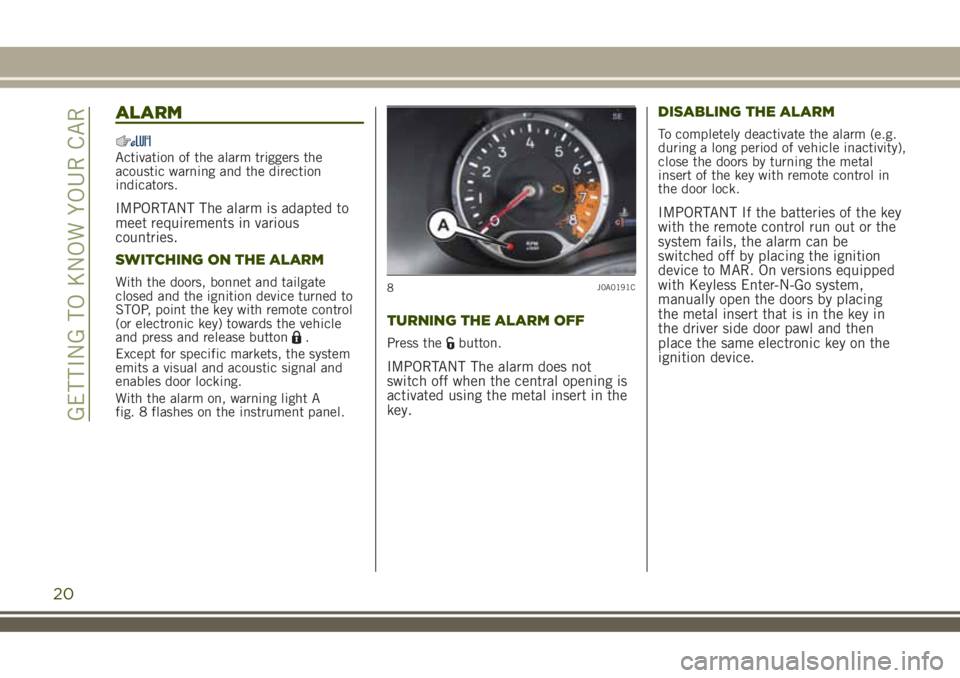
ALARM
Activation of the alarm triggers the
acoustic warning and the direction
indicators.
IMPORTANT The alarm is adapted to
meet requirements in various
countries.
SWITCHING ON THE ALARM
With the doors, bonnet and tailgate
closed and the ignition device turned to
STOP, point the key with remote control
(or electronic key) towards the vehicle
and press and release button
.
Except for specific markets, the system
emits a visual and acoustic signal and
enables door locking.
With the alarm on, warning light A
fig. 8 flashes on the instrument panel.
TURNING THE ALARM OFF
Press thebutton.
IMPORTANT The alarm does not
switch off when the central opening is
activated using the metal insert in the
key.DISABLING THE ALARM
To completely deactivate the alarm (e.g.
during a long period of vehicle inactivity),
close the doors by turning the metal
insert of the key with remote control in
the door lock.
IMPORTANT If the batteries of the key
with the remote control run out or the
system fails, the alarm can be
switched off by placing the ignition
device to MAR. On versions equipped
with Keyless Enter-N-Go system,
manually open the doors by placing
the metal insert that is in the key in
the driver side door pawl and then
place the same electronic key on the
ignition device.
8J0A0191C
20
GETTING TO KNOW YOUR CAR
Page 23 of 356
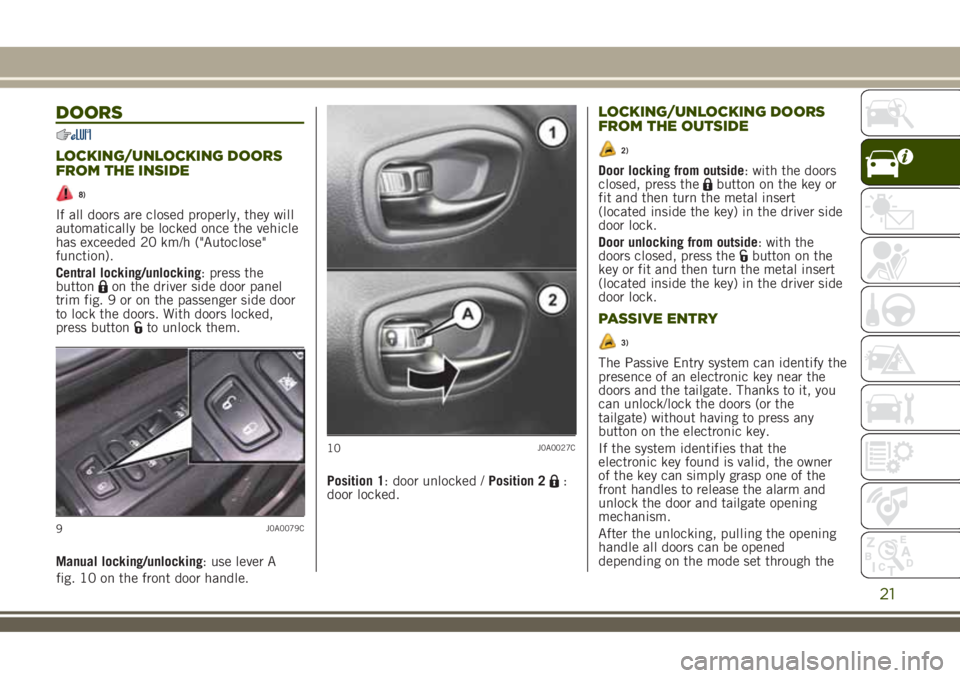
DOORS
LOCKING/UNLOCKING DOORS
FROM THE INSIDE
8)
If all doors are closed properly, they will
automatically be locked once the vehicle
has exceeded 20 km/h ("Autoclose"
function).
Central locking/unlocking: press the
button
on the driver side door panel
trim fig. 9 or on the passenger side door
to lock the doors. With doors locked,
press button
to unlock them.
Manual locking/unlocking: use lever A
fig. 10 on the front door handle.Position 1: door unlocked /Position 2
:
door locked.
LOCKING/UNLOCKING DOORS
FROM THE OUTSIDE
2)
Door locking from outside: with the doors
closed, press thebutton on the key or
fit and then turn the metal insert
(located inside the key) in the driver side
door lock.
Door unlocking from outside: with the
doors closed, press the
button on the
key or fit and then turn the metal insert
(located inside the key) in the driver side
door lock.
PASSIVE ENTRY
3)
The Passive Entry system can identify the
presence of an electronic key near the
doors and the tailgate. Thanks to it, you
can unlock/lock the doors (or the
tailgate) without having to press any
button on the electronic key.
If the system identifies that the
electronic key found is valid, the owner
of the key can simply grasp one of the
front handles to release the alarm and
unlock the door and tailgate opening
mechanism.
After the unlocking, pulling the opening
handle all doors can be opened
depending on the mode set through the
9J0A0079C
10J0A0027C
21
Page 24 of 356
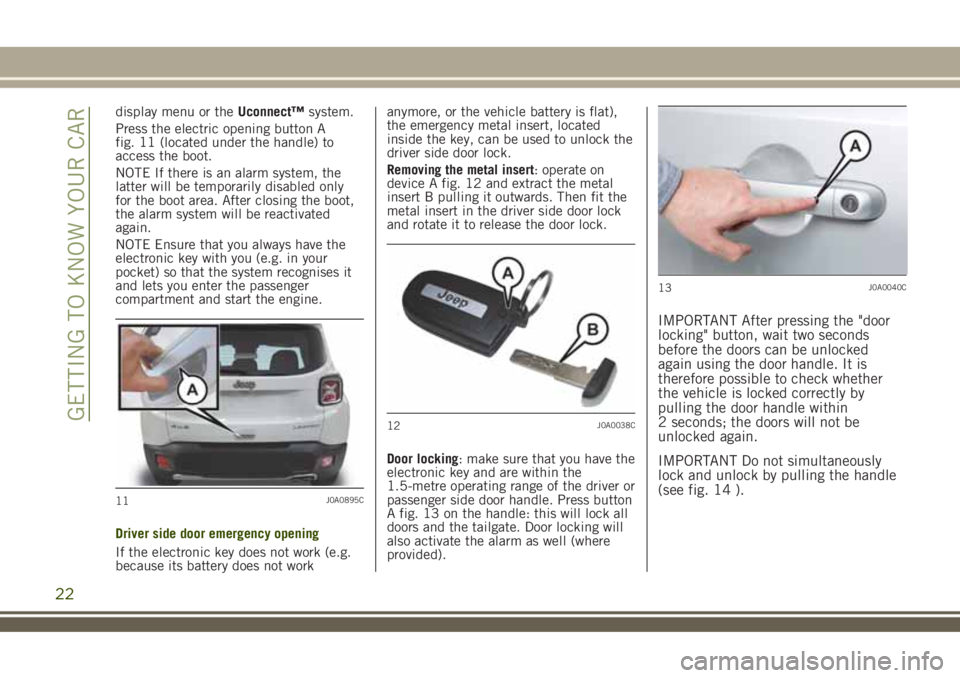
display menu or theUconnect™system.
Press the electric opening button A
fig. 11 (located under the handle) to
access the boot.
NOTE If there is an alarm system, the
latter will be temporarily disabled only
for the boot area. After closing the boot,
the alarm system will be reactivated
again.
NOTE Ensure that you always have the
electronic key with you (e.g. in your
pocket) so that the system recognises it
and lets you enter the passenger
compartment and start the engine.
Driver side door emergency opening
If the electronic key does not work (e.g.
because its battery does not workanymore, or the vehicle battery is flat),
the emergency metal insert, located
inside the key, can be used to unlock the
driver side door lock.
Removing the metal insert: operate on
device A fig. 12 and extract the metal
insert B pulling it outwards. Then fit the
metal insert in the driver side door lock
and rotate it to release the door lock.
Door locking: make sure that you have the
electronic key and are within the
1.5-metre operating range of the driver or
passenger side door handle. Press button
A fig. 13 on the handle: this will lock all
doors and the tailgate. Door locking will
also activate the alarm as well (where
provided).
IMPORTANT After pressing the "door
locking" button, wait two seconds
before the doors can be unlocked
again using the door handle. It is
therefore possible to check whether
the vehicle is locked correctly by
pulling the door handle within
2 seconds; the doors will not be
unlocked again.
IMPORTANT Do not simultaneously
lock and unlock by pulling the handle
(see fig. 14 ).
11J0A0895C
12J0A0038C
13J0A0040C
22
GETTING TO KNOW YOUR CAR
Page 88 of 356
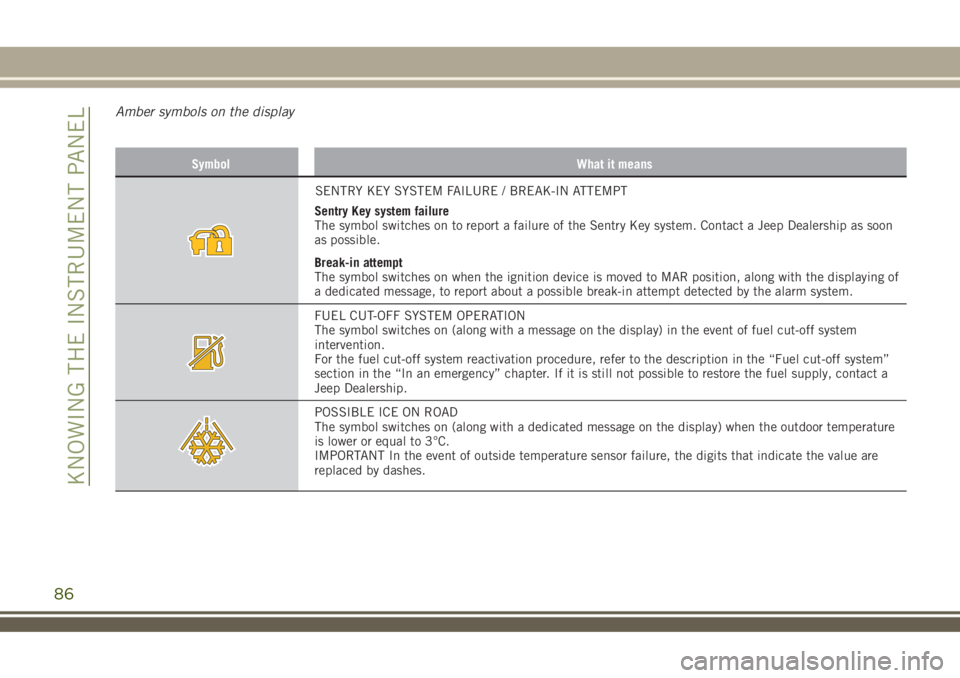
Amber symbols on the display
Symbol What it means
SENTRY KEY SYSTEM FAILURE / BREAK-IN ATTEMPT
Sentry Key system failure
The symbol switches on to report a failure of the Sentry Key system. Contact a Jeep Dealership as soon
as possible.
Break-in attempt
The symbol switches on when the ignition device is moved to MAR position, along with the displaying of
a dedicated message, to report about a possible break-in attempt detected by the alarm system.
FUEL CUT-OFF SYSTEM OPERATION
The symbol switches on (along with a message on the display) in the event of fuel cut-off system
intervention.
For the fuel cut-off system reactivation procedure, refer to the description in the “Fuel cut-off system”
section in the “In an emergency” chapter. If it is still not possible to restore the fuel supply, contact a
Jeep Dealership.
POSSIBLE ICE ON ROAD
The symbol switches on (along with a dedicated message on the display) when the outdoor temperature
is lower or equal to 3°C.
IMPORTANT In the event of outside temperature sensor failure, the digits that indicate the value are
replaced by dashes.
86
KNOWING THE INSTRUMENT PANEL
Page 114 of 356
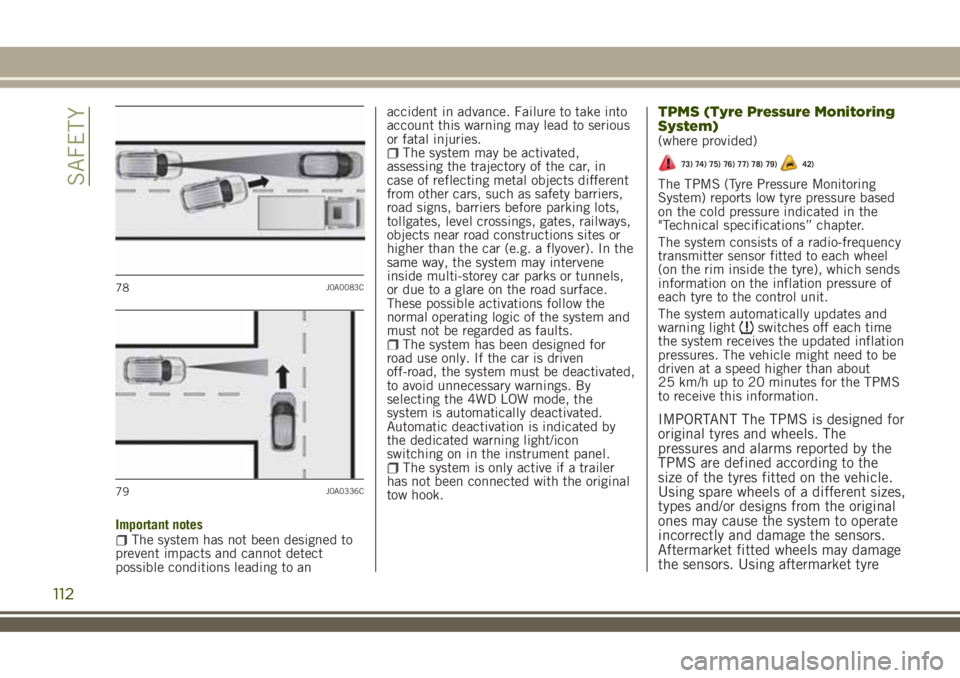
Important notesThe system has not been designed to
prevent impacts and cannot detect
possible conditions leading to anaccident in advance. Failure to take into
account this warning may lead to serious
or fatal injuries.
The system may be activated,
assessing the trajectory of the car, in
case of reflecting metal objects different
from other cars, such as safety barriers,
road signs, barriers before parking lots,
tollgates, level crossings, gates, railways,
objects near road constructions sites or
higher than the car (e.g. a flyover). In the
same way, the system may intervene
inside multi-storey car parks or tunnels,
or due to a glare on the road surface.
These possible activations follow the
normal operating logic of the system and
must not be regarded as faults.
The system has been designed for
road use only. If the car is driven
off-road, the system must be deactivated,
to avoid unnecessary warnings. By
selecting the 4WD LOW mode, the
system is automatically deactivated.
Automatic deactivation is indicated by
the dedicated warning light/icon
switching on in the instrument panel.
The system is only active if a trailer
has not been connected with the original
tow hook.
TPMS (Tyre Pressure Monitoring
System)
(where provided)
73) 74) 75) 76) 77) 78) 79)42)
The TPMS (Tyre Pressure Monitoring
System) reports low tyre pressure based
on the cold pressure indicated in the
"Technical specifications” chapter.
The system consists of a radio-frequency
transmitter sensor fitted to each wheel
(on the rim inside the tyre), which sends
information on the inflation pressure of
each tyre to the control unit.
The system automatically updates and
warning light
switches off each time
the system receives the updated inflation
pressures. The vehicle might need to be
driven at a speed higher than about
25 km/h up to 20 minutes for the TPMS
to receive this information.
IMPORTANT The TPMS is designed for
original tyres and wheels. The
pressures and alarms reported by the
TPMS are defined according to the
size of the tyres fitted on the vehicle.
Using spare wheels of a different sizes,
types and/or designs from the original
ones may cause the system to operate
incorrectly and damage the sensors.
Aftermarket fitted wheels may damage
the sensors. Using aftermarket tyre
78J0A0083C
79J0A0336C
112
SAFETY
Page 209 of 356

DASHBOARD FUSE BOXfig. 165
USERSFUSE AMPERE
Front electric window (passenger side) F33 20
Front electric window (driver side) F34 20
System power supply
Uconnect™Climate Control system, Alarm, Electric door mirror folding,
EOBD system, USB portF36 15
Safe Lock device (Driver side door unlocking - where
provided)/Door unlocking/Central locking/Electric tailgate
unlockingF38 20
Windscreen/rear window washer pump F43 20
Rear left electric window F47 20
Rear right electric window F48 20
Cigar lighter (where provided) F94 15
207
Page 310 of 356
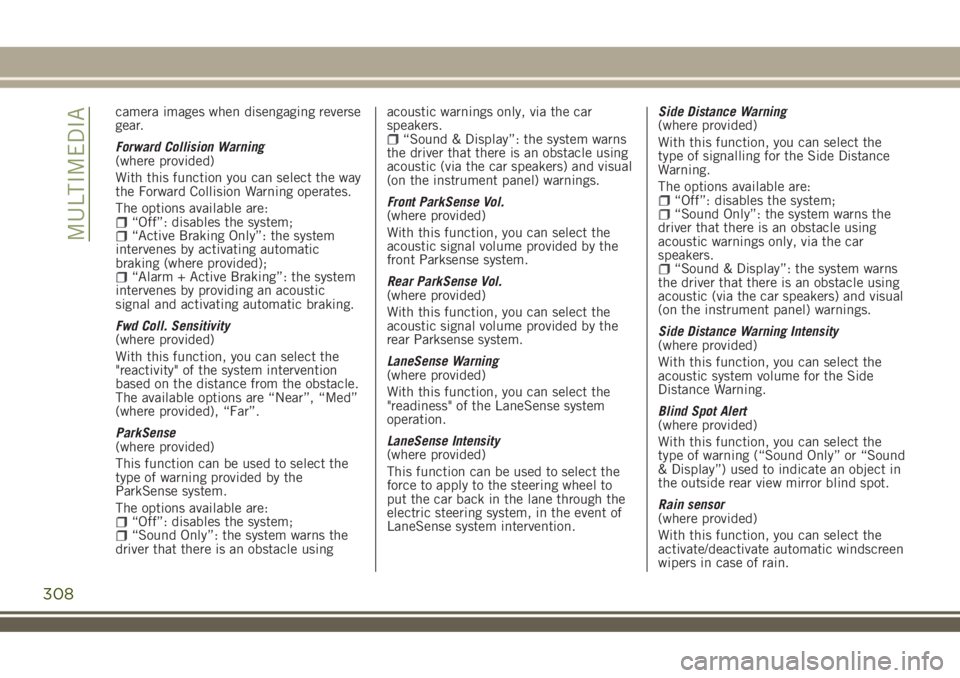
camera images when disengaging reverse
gear.
Forward Collision Warning
(where provided)
With this function you can select the way
the Forward Collision Warning operates.
The options available are:
“Off”: disables the system;“Active Braking Only”: the system
intervenes by activating automatic
braking (where provided);
“Alarm + Active Braking”: the system
intervenes by providing an acoustic
signal and activating automatic braking.
Fwd Coll. Sensitivity
(where provided)
With this function, you can select the
"reactivity" of the system intervention
based on the distance from the obstacle.
The available options are “Near”, “Med”
(where provided), “Far”.
ParkSense
(where provided)
This function can be used to select the
type of warning provided by the
ParkSense system.
The options available are:
“Off”: disables the system;“Sound Only”: the system warns the
driver that there is an obstacle usingacoustic warnings only, via the car
speakers.
“Sound & Display”: the system warns
the driver that there is an obstacle using
acoustic (via the car speakers) and visual
(on the instrument panel) warnings.
Front ParkSense Vol.
(where provided)
With this function, you can select the
acoustic signal volume provided by the
front Parksense system.
Rear ParkSense Vol.
(where provided)
With this function, you can select the
acoustic signal volume provided by the
rear Parksense system.
LaneSense Warning
(where provided)
With this function, you can select the
"readiness" of the LaneSense system
operation.
LaneSense Intensity
(where provided)
This function can be used to select the
force to apply to the steering wheel to
put the car back in the lane through the
electric steering system, in the event of
LaneSense system intervention.Side Distance Warning
(where provided)
With this function, you can select the
type of signalling for the Side Distance
Warning.
The options available are:
“Off”: disables the system;“Sound Only”: the system warns the
driver that there is an obstacle using
acoustic warnings only, via the car
speakers.
“Sound & Display”: the system warns
the driver that there is an obstacle using
acoustic (via the car speakers) and visual
(on the instrument panel) warnings.
Side Distance Warning Intensity
(where provided)
With this function, you can select the
acoustic system volume for the Side
Distance Warning.
Blind Spot Alert
(where provided)
With this function, you can select the
type of warning (“Sound Only” or “Sound
& Display”) used to indicate an object in
the outside rear view mirror blind spot.
Rain sensor
(where provided)
With this function, you can select the
activate/deactivate automatic windscreen
wipers in case of rain.
308
MULTIMEDIA
Page 351 of 356
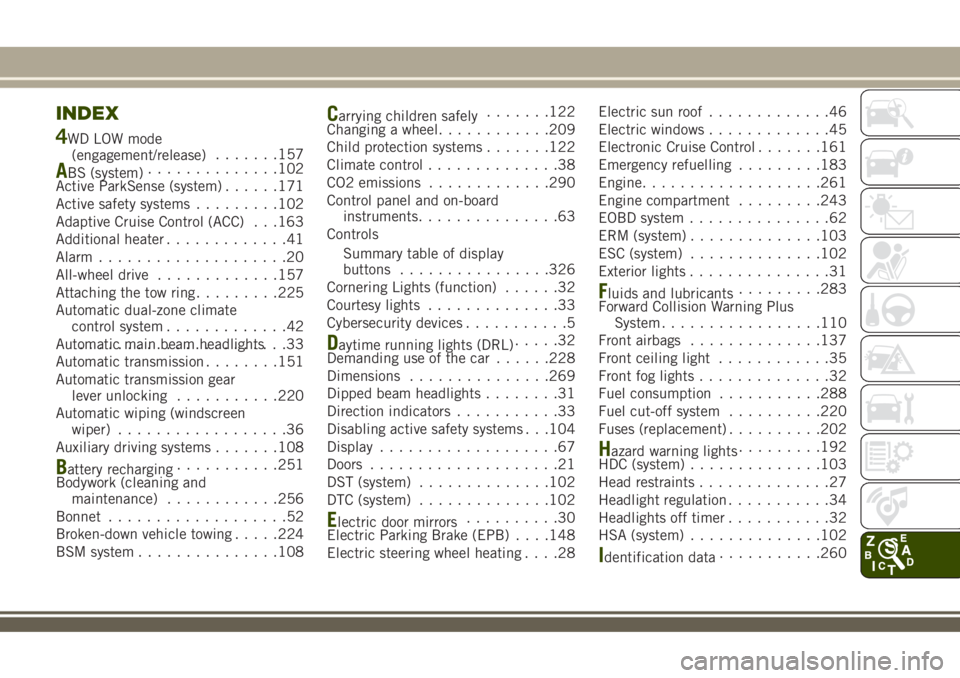
INDEX
4WD LOW mode
(engagement/release).......157
ABS (system)..............102
Active ParkSense (system)......171
Active safety systems.........102
Adaptive Cruise Control (ACC) . . .163
Additional heater.............41
Alarm....................20
All-wheel drive.............157
Attaching the tow ring.........225
Automatic dual-zone climate
control system.............42
Automatic main beam headlights......................33
Automatic transmission........151
Automatic transmission gear
lever unlocking...........220
Automatic wiping (windscreen
wiper)..................36
Auxiliary driving systems.......108
Battery recharging...........251
Bodywork (cleaning and
maintenance)............256
Bonnet...................52
Broken-down vehicle towing.....224
BSM system...............108
Carrying children safely.......122
Changing a wheel............209
Child protection systems.......122
Climate control..............38
CO2 emissions.............290
Control panel and on-board
instruments...............63
Controls
Summary table of display
buttons................326
Cornering Lights (function)......32
Courtesy lights..............33
Cybersecurity devices...........5
Daytime running lights (DRL).....32
Demanding use of the car......228
Dimensions...............269
Dipped beam headlights........31
Direction indicators...........33
Disabling active safety systems . . .104
Display...................67
Doors....................21
DST (system)..............102
DTC (system)..............102
Electric door mirrors..........30
Electric Parking Brake (EPB). . . .148
Electric steering wheel heating....28Electric sun roof.............46
Electric windows.............45
Electronic Cruise Control.......161
Emergency refuelling.........183
Engine...................261
Engine compartment.........243
EOBD system...............62
ERM (system)..............103
ESC (system)..............102
Exterior lights...............31
Fluids and lubricants.........283
Forward Collision Warning Plus
System.................110
Front airbags..............137
Front ceiling light............35
Front fog lights..............32
Fuel consumption...........288
Fuel cut-off system..........220
Fuses (replacement)..........202
Hazard warning lights.........192
HDC (system)..............103
Head restraints..............27
Headlight regulation...........34
Headlights off timer...........32
HSA (system)..............102
Identification data...........260